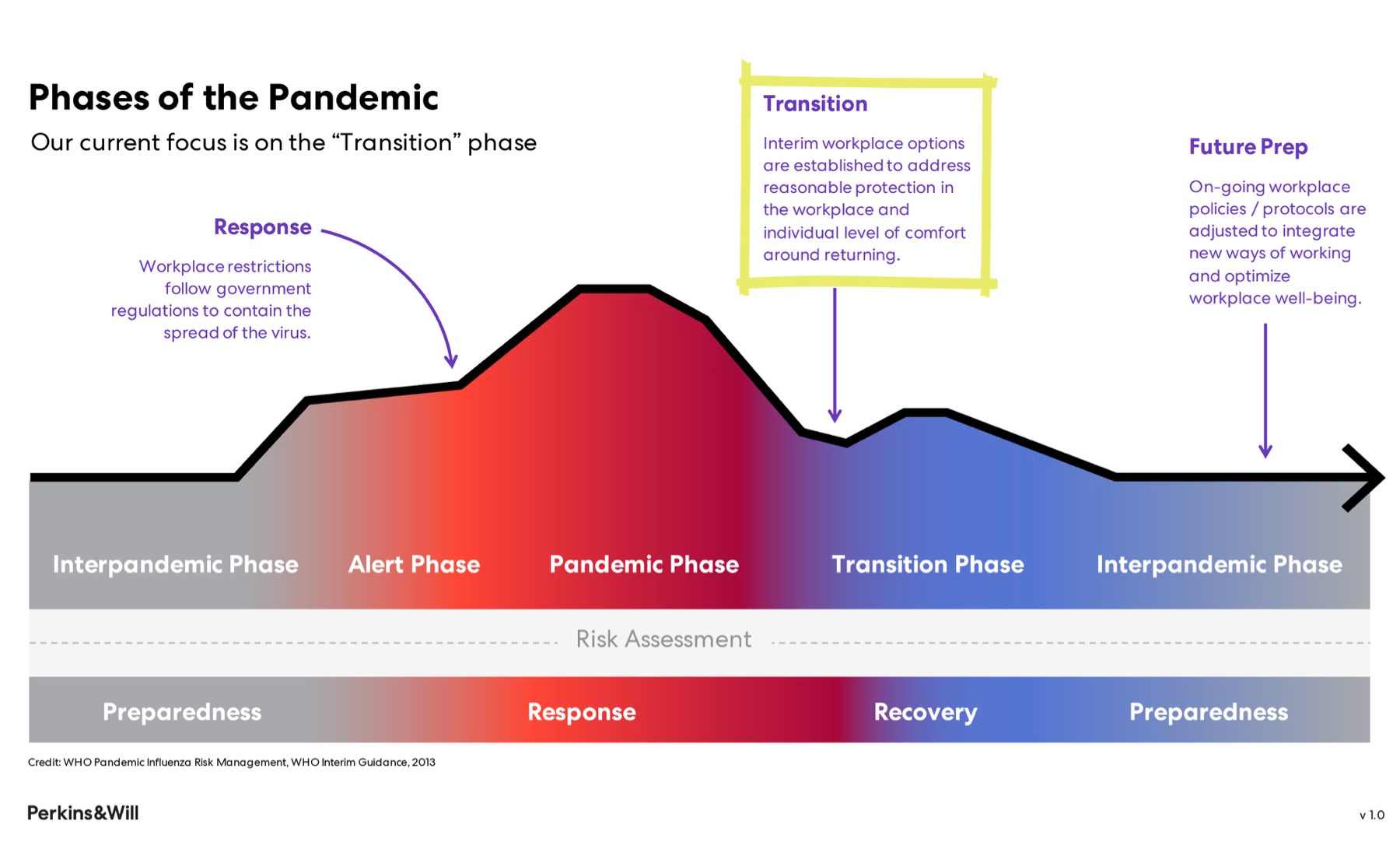With enormous pressure to restart the economy and reopen businesses closed by the COVID-19 pandemic, architects are considering how best to help their clients. But with limited information, much remains unknown about the landscape of the infection: How far must we distance ourselves? How long does the virus linger on surfaces and in the air? Do antibodies provide immunity? And when should those at higher risk return to work?
There does seem to be a consensus around remote work: it’s here to stay, with long-term repercussions for the design of, and need for, office space. “The office may be increasingly dedicated to times when we want to be together,” says Julia Murphy, a director at Skidmore, Owings & Merrill (SOM) in New York, while home is for focused, concentrated tasks. A more flexible attitude about telecommuting can also help people with child- or elder-care responsibilities.
Perkins and Will is among several firms that have published documents to assist clients in reopening their offices. “The Roadmap for Return” is grounded in public-health guidance and brings together physical, operational, and personnel considerations. In discussing the recommendations in one-hour sessions with clients, “The need to have a plan in place is a consistent theme,” says Lisa Pool, the firm’s Minneapolis-based director of workplace strategy, “one that brings people back gradually.”

In surveying clients, Gensler expects only small numbers of people will return to offices on “day one”—perhaps just 10 percent, says Michael Chappell, the director of strategy at the company’s New York City office. (Perkins and Will’s guidance anticipates 20 to 40 percent.) “There is lots of momentum, but lots of caution,” says Greg Mottola, a San Francisco–based principal of Bohlin Cywinski Jackson. He says the tech company Square, a client, “is telling everyone to work at home until fall. They don’t want the risky commute. They don’t want to force staff to come in when they can’t get child care, and they don’t want to burden the health-care system with cases when they’ve been able to work so effectively at home.”

An office’s ability to accommodate six feet of distance between employees may determine how many people can come back at first. And meetings are another fraught question, since most rooms capacities will be halved, with many participants telecommuting. “If we can’t use meeting rooms and we must lower the density of people in our office, we’re asking ourselves whether we want to go back yet,” says Pool. “For what?” While working remotely, “You can’t walk up to someone’s desk impromptu and chat about what they’re doing,” says Mottola. “We’re desperately trying to maintain the ability to be creative together.”
The need for social distancing has also spurred conversations about the viability of shared gathering spaces and solidarity-building refreshment bars. The New York office of SOM was forced to reconsider the collaborative culture embodied in new office space that is near completion. “We remain bullish on the idea that creative people have to come together,” says Murphy. The sentiment extends to most corporate clients, she says. “They have embraced collaborative or shared semi-public spaces to build identity, to reduce silos, and allow different business segments to cross-pollinate. That won’t go away.”
Clients may need help establishing protocols to assure safety. Does a company want to mandate the wearing of masks and gloves? How do you cue appropriate behaviors? “You may want to signal the commitment to disinfection by bringing it front and center, rather than having it happen after hours,” says Gensler’s Chappell.

Staying closed much longer may not be an option for many companies, forcing them to consider risk-reduction strategies that “work now, work when there is a vaccine, and work when the next event hits,” says Carlos Martinez, a principal at Gensler’s New York office. (Pool notes that the World Health Organization does not refer to a post-recovery phase but an “interpandemic” one.) To serve for the short term, some architects are helping clients divide open offices with new partitions or deploy the equivalent of restaurant-buffet sneeze guards between desks. The architecture firm HGA’s “Redefining Workplace” guidelines suggest a number of infection-control alterations pulled from the Center for Health Design. Other practices are taking a wait-and-see attitude on architectural changes that can’t be easily reversed, until more is known about the way the virus operates.
With a growing interest in healthy air that predated COVID-19, Olin McKenzie, an SOM director, believes there will be a willingness to invest in upgraded HVAC systems when evidence shows they are capable of eliminating viruses or diluting their presence.
Tactics associated with the WELL building standard and Active Design Guidelines—ample daylight, access to healthy food, and operable windows, for instance—won’t control contagion but convey a reassuring commitment to health and well-being. Given the traumas and dislocation of this pandemic time, dignity, respect, and affirmation of staff value can go a long way.
Useful Sources of Information
World Health Organization. “Getting Your Workplace Ready for COVID-19.” (March 19, 2020).
World Health Organization. “Risk Communication.” (accessed April 20, 2020).
Occupational Safety and Health Administration. “Guidance on Preparing Workplaces for COVID-19.” (March 2020).
Centers for Disease Control and Prevention. “Interim Guidance for Businesses and Employers to Plan and Respond to Coronavirus Disease 2019 (COVID-19).” (April 9, 2020).
American Institute of Architects. "Re-occupancy Assessment Tool." (May 7)





Post a comment to this article
Report Abusive Comment